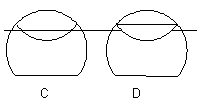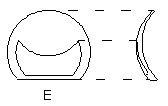< Page 4 of 10 >
1 2 3 4 5 6 7 8 9 10
Presbyopia
The Segment Bifocal is similar in design to a spectacle bifocal lens. As the patient directs the gaze downward the bifocal segment is pushed up for reading. The segment bifocal can sometimes provide better vision for reading than does the concentric design, however it is a thicker lens and will rest on the lower lid giving a greater sensation of lid awareness.
Because of its design, the segment bifocal needs to be stabilized in a vertically oriented position. This is generally achieved through the use of a prism ballast often combined with truncation. The various stabilization techniques will be covered in more detail later on in this section when we discuss toric lenses.
The reading segment is most often crescent shaped and may be either fused on the back of the lens or ground on the front. If it is a fused segment lens, it is also known as a �camp� lens. The reading portion may also be a circle or flat top.


Figures A & B above illustrate a fused crescent shaped �camp� bifocal which is pushed up as the gaze is directed downward.

Figure C above illustrates
a monocentric bifocal lens.The optics are calculated so that no image
jump occurs along the segment line. It is a one-piece design which is
truncated at the bottom. If a bifocal lens is not monocentric, a line
seen through the lens will be displaced as in example D.

Figure E illustrates a crescent shaped fused segment sometimes referred to as a �black� lens.
The Tangent Streak Bifocal is a fused segment bifocal with a very large reading segment. It is prism ballasted, custom made, and available with variable segment heights and a variable optic zone.
|
Patient
Selection For Bifocal Contact Lenses
|
|
| More Likely to Succeed | |
|
1
|
Those who were successful single vision wearers |
|
2
|
Those who are highly motivated and who have a highly motivated fitter |
|
3
|
Those who have an occupational need for bifocal contact lenses |
| Bifocal Soft Lenses Patient Selection | |
|
1
|
Reading addition should be between +1.00 and +1.75 D |
|
2
|
The spherical equivalent should be between -4/00 and +2.00 D with no more thann one diopter of cylinder in the refraction |
|
3
|
The patient should understand that visual acuity under all circumstances may not be as good as it would be with spectacles. Small print in dim lighting conditions may still require reading glasses. |
< Page 4 of 10 >
1 2 3 4 5 6 7 8 9 10